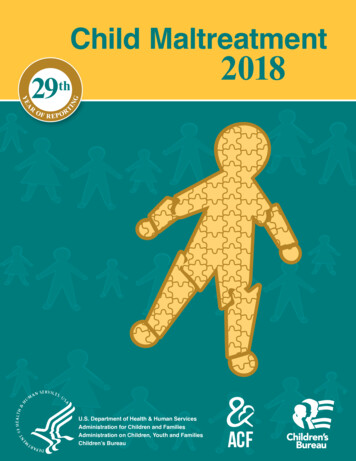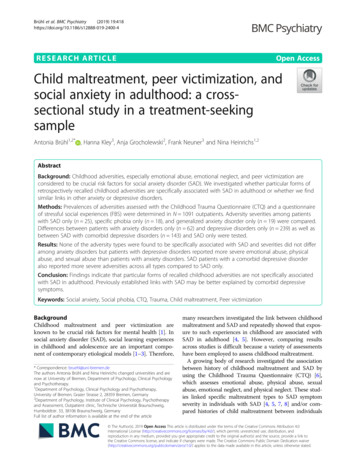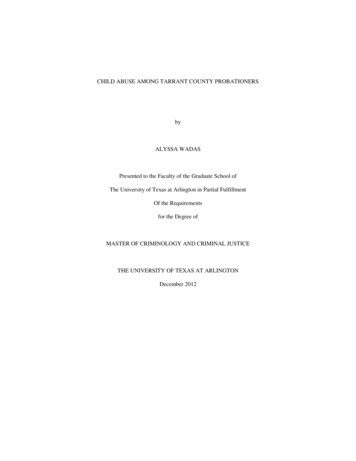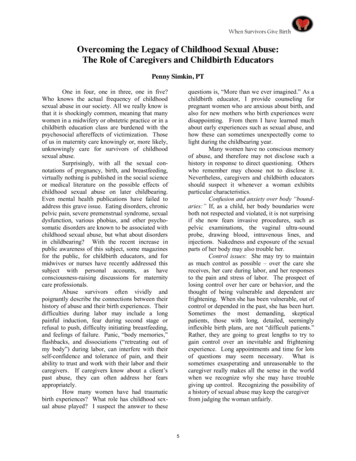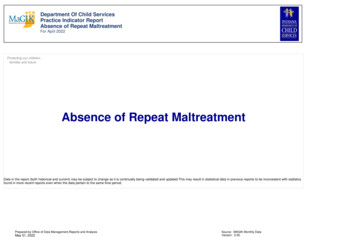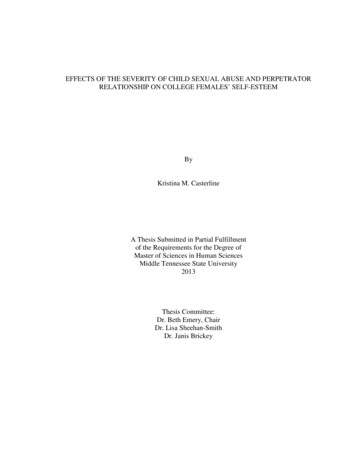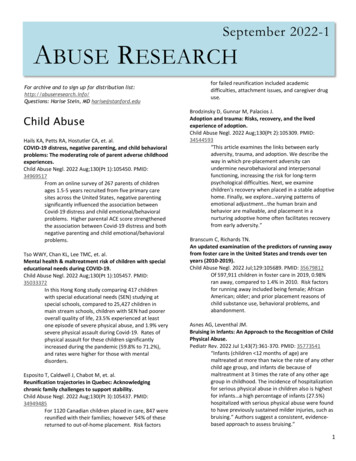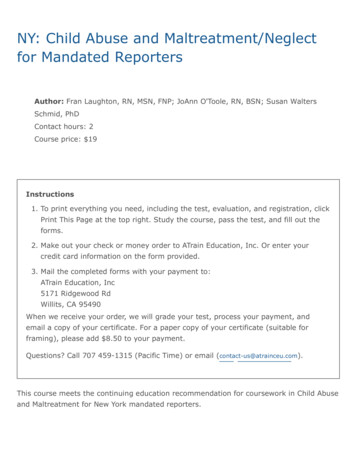
Transcription
NY: Child Abuse and Maltreatment/Neglectfor Mandated ReportersAuthor: Fran Laughton, RN, MSN, FNP; JoAnn O'Toole, RN, BSN; Susan WaltersSchmid, PhDContact hours: 2Course price: 19Instructions1. To print everything you need, including the test, evaluation, and registration, clickPrint This Page at the top right. Study the course, pass the test, and fill out theforms.2. Make out your check or money order to ATrain Education, Inc. Or enter yourcredit card information on the form provided.3. Mail the completed forms with your payment to:ATrain Education, Inc5171 Ridgewood RdWillits, CA 95490When we receive your order, we will grade your test, process your payment, andemail a copy of your certificate. For a paper copy of your certificate (suitable forframing), please add 8.50 to your payment.Questions? Call 707 459-1315 (Pacific Time) or email (contact-us@atrainceu.com).This course meets the continuing education recommendation for coursework in Child Abuseand Maltreatment for New York mandated reporters.
Certificate of Completion: Upon completion you will receive a general certificate ofcompletion. We will send you, via U.S. mail, a second “Certificate of Completion” formrequired by the NY State Education Department. You must complete that form, submit theoriginal to the Department of Education, then return a copy to us.Course SummaryDefines child abuse, maltreatment, and neglect, plus mandated reporters andrequirements for reporting as defined by New York State. Presents indicators of possiblemistreatment, including both physical and behavioral signs.COI SupportAccredited status does not imply endorsement by ATrain Education or any accreditingagency of any products discussed or displayed in this course. The planners and authors ofthis course have declared no conflict of interest and all information is provided fairly andwithout bias.Commercial SupportNo commercial support was received for this activity.Criteria for Successful Completions80% or higher on the post test, a completed evaluation form, and payment whererequired. No partial credit will be awarded.
Course ObjectivesWhen you finish this course you will be able to:1. Briefly describe the problem of child maltreatment in the United States and NewYork State.2. Explain mandated reporting of child abuse or maltreatment/neglect in New YorkState.3. Spell out the legal protections and legal penalties relevant to mandated reporting.4. Define child abuse and maltreatment/neglect in New York State.5. Describe the physical, emotional, and sexual indicators of child abuse.6. Explain what is involved in deciding and preparing to report child abuse in NewYork State.7. Summarize the process of reporting to the NY Statewide Central Register (SCR).The Grave Problem of Child AbuseUnderreporting of suspected child abuse has long been a problem, and while every state,the District of Columbia, and the U.S. Territories mandate reporting by certain individuals(US DHHS, 2018; CDC, 2014, 2014a; Peterson et al., 2014), and most require training forthose reporters, the problem remains. Reasons cited for not reporting include confusion ormisunderstanding about how and what to report and lack of knowledge about the signs ofmistreatment, but research has demonstrated that the reasons are often more complexand can involve personal concerns, system concerns, social constraints, and conflictingloyalties (Guttman, 2015; Hudson, 2017; Krase, 2018; Wolfe, 2012).
Research has also found that the more training mandated reporters receive the moreconfident they feel in making good decisions about their duties to report suspected childmaltreatment (Lusk, 2014; Wolfe, 2012). While most states have penalties for failure toreport, they are often minor and/or rarely imposed (Hudson, 2017; Krase, 2018; Steffen,2016; Wolfe, 2012).The recognition of child abuse in its multiple forms—physical abuse, sexual abuse,emotional abuse, and neglect—came to the fore in the twentieth century and remains aconsiderable social and public health problem throughout the world as well as in the UnitedStates. The national estimate of children who received a child protective services (CPS)investigation response or alternative response increased 9.5% from 2012 (3,172,000) to2016 (3,472,000).The number and rate of victims have fluctuated during the past 5 years but the nationalestimate over that period shows an increase of 3% in the number of victims, from 656,000in 2012 to 676,000 in 2016. Of these 2016 victims, it is estimated that 1,750 children diedof abuse and neglect (DHHS, 2018). Over that same period, New York has experienced a3.8% decline in the number of children receiving an investigation or alternative response, a4.8% decline in the number of child victims, and a slight decrease in the number of childfatalities, which although they had risen in 2013 and 2014 were lower in 2016 than in 2012(DHHS, 2018).That said, any amount of child abuse and neglect is too much. And, as noted above, it isbelieved that these numbers likely underestimate how many children are affected bymaltreatment because many cases go unreported or undetected. A non-CPS study hasestimated that 25% of U.S. children experience some form of child maltreatment in theirlifetimes (CDC, 2017; 2014).A Centers for Disease Control and Prevention (CDC) study found that the total lifetimeestimated financial costs associated with just one year of confirmed cases of childmaltreatment (physical abuse, sexual abuse, psychological abuse and neglect) isapproximately 124 billion (CDC, 2014b). In addition, survivors of child abuse can be leftwith physical and emotional scars that last a lifetime. Children who have experiencedabuse and neglect are at increased risk of adverse health outcomes and risky healthbehaviors in adolescence and adulthood. Child maltreatment has been linked to higherrates of alcoholism, drug abuse, depression, smoking, multiple sexual partners, suicide,and chronic disease (CDC, 2014b).
The most recent data for New York State (calendar year 2016) show that for every 1000children in the state 43.8 were named as an alleged victim of abuse/maltreatment in atleast one CPS report, and for 14.5 of every 1000 children the allegations weresubstantiated. There were totals of 191,769 alleged victims and 63,578 substantiatedvictims (NYOCFS, 2017a).Statistics from the U.S. Department of Health and Human Services (HHS) show that,nationwide, neglect represents the largest percentage of cases of child maltreatment, andthe same holds true in New York State.Types of Maltreatment, 2016Type of maltreatmentUnited StatesNew York StateNeglect74.8%95.4%Physical Abuse18.2%9.6%Sexual Abuse8.5%3.2%Psychological maltreatment5.6%0.7%Medical neglect2.1%5.9%Other types6.9%27.8%Source: DHHS, 2018.Federal legislation provides guidance to states by identifying a minimum set of acts orbehaviors that define child abuse and neglect. The Federal Child Abuse Prevention andTreatment Act (CAPTA) (42 U.S.C.A. § 5106g), as amended by the CAPTA ReauthorizationAct of 2010, defines child abuse and neglect as, at minimum:Any recent act or failure to act on the part of a parent or caretaker which results indeath, serious physical or emotional harm, sexual abuse or exploitation; orAn act or failure to act which presents an imminent risk of serious harm.This definition of child abuse and neglect refers specifically to parents and other caregivers.A “child” under this definition generally means a person who is younger than age 18 orwho is not an emancipated minor.
While CAPTA provides definitions for sexual abuse and the special cases of neglect relatedto withholding or failing to provide medically indicated treatment, it does not providespecific definitions for other types of maltreatment such as physical abuse, neglect, oremotional abuse. Although federal legislation sets minimum standards for states thataccept CAPTA funding, each state provides its own definitions of maltreatment within civiland criminal statutes (DHHS, 2018).New York State Child Protective Services SystemMandated Reporting and Child ProtectiveServices in NYS
Guided by the minimum standards set by federal law, individual states have their owndefinitions of child abuse and neglect, and in addition each state has mandatory reportinglaws that require certain professionals and institutions to report suspected childmaltreatment to a child protective services (CPS) agency. These people are calledmandated reporters (DHHS, 2018). As mandated reporters, healthcare professionals are ina unique position to recognize and report abuse that is perpetrated on these helplessvictims.In the 1973 Child Protective Services Act: New York, in order to protect children who arevictims of abuse or maltreatment, created a child protective system in statute with fivefundamental components:1.State Central Register of reports of suspected child abuse and maltreatment;2.Detection through third-party recognition of children in danger, includingmandatory and voluntary reporting of suspected child abuse and maltreatment;3.Child protective services (a) to verify reports, (b) to provide immediateprotection of children and (c) to begin the process of helping families byproviding rehabilitative and ameliorative services;4.Emergency protective custody of children in “imminent danger”; and5.When necessary, court action–Family Court action to remove a child, remove theallegedly abusive or neglectful parent from the child’s residence, imposetreatment and/or Criminal Court action (by referring the case to lawenforcement) to prosecute the perpetrator (New York State Assembly, 2014).Today the laws that guide New York CPS services are Article 6, Title 6 of the Social ServicesLaw and Article 10 of the Family Court Act.Article 6, Title 6. CHILD PROTECTIVE SERVICES includes the following sections:
411 - Findings and purpose.412 - General definitions.413 - Persons and officials required to report cases of suspected child abuse ormaltreatment.414 - Any person permitted to report.415 - Reporting procedure.416 - Obligations of persons required to report.417 - Taking a child into protective custody.418 - Mandatory reporting to and post-mortem investigation of deaths by medicalexaminer or coroner.419 - Immunity from liability.420 - Penalties for failure to report.421 - Responsibility of the office.422 - Statewide central register of child abuse and maltreatment.422-A - Child abuse and neglect investigations; disclosure.422-B - Local and regional fatality review teams.422-C - Establishment of the child abuse medical provider program (CHAMP).423 - Child protective service responsibilities and organization; purchase of service andreimbursement of cost; local plan.423-A - Child advocacy centers established.424 - Duties of the child protective service concerning reports of abuse or maltreatment.424-A - Access to information contained in the statewide central register of child abuse andmaltreatment.424-B - Children in the care of certain public and private agencies.425 - Cooperation of other agencies.426 - Annual reports.427 - Regulations of the commissioner.427-A - Differential response programs for child protection assessments or investigations.428 - Separability.Who Is Mandated to Report?New York State recognizes that certain professionals are specially equipped to perform theimportant role of mandated reporter of child abuse or maltreatment. These include:Physicians, registered physician assistants, surgeons, medical examiners, coroners,dentists, dental hygienists, osteopaths, optometrists, chiropractors, podiatrists,residents, interns, psychologists, registered nurses, social workers, or emergencymedical technicians
Licensed creative arts therapists, marriage and family therapists, mental healthcounselors, or psychoanalystsLicensed behavior analysts and certified behavior analyst assistantsHospital personnel (who admit, examine, care for, or treat persons)Christian Science practitionersSchool officials, including but not limited to teachers, guidance counselors,psychologists, social workers, nurses, administrators, or other school personnelrequired to hold teaching or administrative licenses/certificates, full or part-timecompensated school employees required to hold a temporary coaching license orprofessional coaching certificateSocial services workers, employee of a publicly funded emergency shelter for familieswith children, directors of children’s camps, daycare center workers, school-age childcare workers, providers of family or group family daycare, employees or volunteers ina residential care facility for children, or any other child care or foster care workerMental health professionals, substance abuse counselors, alcoholism counselors, oranyone credentialed by the NYS Office of Alcoholism and Substance Abuse ServicesPeace officers, police officers, district attorneys or assistant district attorneys,investigators employed in the office of a district attorney, or other law enforcementofficials (SSL §413; NYSOCFS, 2017, 2016)This list is periodically revised and updated through legislation.In addition, since January 1, 1989 the New York State Education Law has required certainindividuals, when initially applying for licensure or a limited permit, to show that they havecompleted the required training in the identification and reporting of child abuse andmaltreatment. Periodically since 1989 the list of covered professions and specificrequirements has been expanded. Complete information can be obtained from the NYSEducation Department (NYSED, 2017a).A mandated reporter is required in the state of New York to report suspected child abuse ormaltreatment when they are presented with a reasonable cause to suspect child abuse ormaltreatment in a situation where a child, parent, or other person legally responsible forthe child is before the mandated reporter when the mandated reporter is acting in his orher official or professional capacity (SSL §413; NYSOCFS, 2016).While anyone may make a report of suspected abuse, reports made by mandated reportersare more likely to be registered—accepted by the SCR for further investigation. It seemslikely that this is due, at least in part, to better reporting based on training andprofessional awareness (NYSOCFS, 2011).
Numerous pieces of legislation related to mandatory reporters and reporting have beenintroduced in the New York legislature in recent years. The only one enacted occurred in2014 when New York began requiring school athletic directors and school personnel orother persons required to hold a temporary coaching license or professional coachingcertificate to report cases of suspected child abuse (NCSL, 2012–2015). However, as ofApril 2018, there is a bill pending in the New York State Legislature (Senate Bill S2158A)that would “require mandated reporters to report to law enforcement suspected childabuse involving a person in a position of authority or a position of trust” (NY State Senate,2018).Did You Know . . .Any other person who has reasonable cause to suspect that a child isabused or maltreated may also report (SS Law § 414).What Is a Mandated Reporter’s Role?[This section is taken directly from NYS SSL §413.]A mandated reporter’s role is, while acting in their professional or official capacity, to:Report suspected incidents of child abuse or maltreatment/neglect.Make the report to the SCR immediately upon the development of reasonable cause tosuspect child abuse or maltreatment.New York’s Social Services Law §413 requires reports when:Reporter has reasonable cause to suspect that a child coming before the reporter inhis or her professional or official capacity is an abused or maltreated child.Reporter has reasonable cause to suspect that a child is an abused or maltreated childwhere the parent, guardian, custodian, or other person legally responsible for thechild comes before them in their professional official capacity and states—frompersonal knowledge—facts, conditions, or circumstances that, if correct, would renderthe child an abused or maltreated child.The law also states that (1) whenever a mandated reporter is required to report as amember of the staff of a medical or other public or private institution, school, facility, oragency, he or she shall make the report as required—reports must contain the names of allother staff persons with direct knowledge of the allegations—but the law does not requiremore than one report from the agency for a single incident; and, (2) no retaliatorypersonnel action is allowed (SSL §413; NYSOCFS, 2016).
Additional Requirements for Social Service WorkersSocial service workers only are additionally required to report or cause a report to be madewhen any person comes before them in their professional or official capacity withinformation from personal knowledge that causes them to have reasonable cause tosuspect that a child is an abused or maltreated child [SSL §413(1)(d)].All other mandated reporters are required to report or cause a report to be made onlywhen confronted with a child who they suspect to be abused or maltreated or when aparent, guardian, custodian or other person legally responsible for a child providesinformation which, if true, would mean that child was abused or maltreated [SSL §413(1)(a)]. Further, any person is permitted to report any reasonable suspicion of abuse ormaltreatment no matter how that information is brought to their attention [SSL §414], andOCFS encourages such reporting (NYSOCFS, 2017, Chapter 2, page A‑2).Institutional Reporting ParadigmMandated Reporter w/direct knowledge must call the SCRMandated Reporter notifies Agency Administrator (or reporting designee)immediatelyAgency Administrator (or designee) is responsible for all subsequent administrationof the report, includingFiling the LDSS-2221AMaintaining the Call ID #Providing SCR with contact information for every staff person of the institutionbelieved to have direct knowledge of the allegations in the reportSource: NYSOCFS, 2017.What Is Professional Capacity?If a person is acting within the scope of their employment or carrying out functions as partof the duties and responsibilities of their profession, they are acting in a professionalcapacity (NYSOCFS, 2016).
For example, healthcare providers examining a child in their practice who have areasonable suspicion of abuse must report the concern. However, if the same personwitnesses child abuse while playing tennis at a local park, he or she is not mandated toreport that abuse. Mandated reporters’ legal responsibility to report suspectedchild abuse or maltreatment ceases when they stop practicing their profession. Asnoted above, however, anyone may report any suspected abuse or maltreatment at anytime (NYSOCFS, 2016).Legal Framework for Mandated Reportingin NYSLegal ProtectionsImmunity from LiabilityThe Social Service Law provides immunity from liability for mandated reporters who reportto the SCR, and this can be especially important for a reporter concerned about legalobligations as a reporter and legal obligations to client or patient confidentiality. If thereport was made in good faith, a mandated reporter is immune from any criminal or civilliability. The good faith of a mandated reporter is presumed. Thus, if someone accuses youof making a false report in bad faith, they must prove gross negligence or willfulmisconduct on your part (SSL §419, NYSOCFS, 2017, 2016, 2011).Source ConfidentialityNew York’s Social Service Law provides confidentiality to those who make a report. OCFSand local CPS are not permitted to release to the subject of the report any data that wouldidentify the source of a report, unless the source has given them written permission to doso. Information regarding the source of the report may be shared with certain individuals(eg, courts, police, district attorney), but only as provided by law (SSL §422(4)(A),NYSOCFS, 2016).Protection from Retaliatory Personnel Action
Section 413 of the Social Services Law, which defines mandated reporters, also specifiesthat no medical or other public or private institution, school, facility, or agency shall takeany retaliatory personnel action against an employee who makes a report to the SCR.Furthermore, no school, school official, childcare provider, foster care provider, residentialcare facility provider, hospital, medical institution provider, or mental health facilityprovider shall impose any conditions, including prior approval or prior notification, upon amember of their staff mandated to report suspected child abuse or maltreatment (SSL§413, NYSOCFS, 2016).Legal PenaltiesFailure to ReportAnytime mandated reporters suspect child abuse or maltreatment—and fail to report it—they can be found guilty of a Class A misdemeanor. This misdemeanor can result in apenalty of up to a year in jail, a fine of up to 1,000, or both. In addition, a mandatedreporter who fails to make a required report to the SCR can be sued in civil court formonetary damages for any harm caused by the failure to report, including wrongful death(NYSOCFS, 2017, 2016).False ReportingThe New York Social Services Law contains a provision (§422.14) by which suspected casesof false reporting of child abuse to the SCR can be referred to an appropriate lawenforcement agency or district attorney. Such false reports are a violation of the Penal Law(Section 240.50(4).Mandated Reporter RecordsSection 415 of the Social Services Law requires mandated reporters who make a report tothe SCR that results in an investigation of an allegation of child abuse or maltreatment tocomply with all requests made by CPS for records relating to that report. This includesinformation that may be covered by privileges stipulated in state law (eg, psychologistclient privilege) and any other law to the contrary (SSL §415, NYSOCFS, 2017).Records available to CPS include:Records relating to diagnosis, prognosis, or treatmentClinical records of any patient or client (NYSOCFS, 2017)
The purpose for requesting these records is to facilitate a full investigation of allegations ofchild abuse or maltreatment. Disclosure of substance abuse treatment records, however, isregulated by federal law and must follow that law’s standards and procedures (NYSOCFS,2017).Written reports from mandated reporters shall be admissible in evidence in anyproceedings relating to child abuse or maltreatment. It is important to be aware that“federal Health Insurance Portability and Accountability Act of 1996 (HIPAA) regulations[45 CFR 160.203(c)] state that HIPAA privacy rules do not apply to reporting of childabuse.” Exceptions stipulate that healthcare providers suspecting child abuse ormaltreatment must report it and provide material in accordance with state law (NYSOCFS,2017).The mandated reporter, as the owner of the records, makes the first determination of whatinformation being sought by CPS is essential to its investigation. If CPS is requestingadditional information essential to the report that the reporter is unwilling to release, CPSshould clearly explain how the records are pertinent. If the reporter still does not producethe reports CPS can provide an appropriate authorization or release, or obtain a courtorder requiring the records be produced (NYSOCFS, 2017).Did You Know . . .Disclosure of substance abuse treatment records is regulated by federallaw.Defining Child Abuse andMaltreatment/NeglectUnder New York law, children are defined as individuals from birth up to 18 years of age.Thus, one cannot report prenatal abuse, but if a child is born with neonatal drugwithdrawal a report can be made. In addition, youth no more than 21 years of age whohave handicapping conditions and are in residential care in certain New York schools for theblind or deaf or in private residential schools for special education services may also bereported to the SCR (NYSOCFS, 2011).If you suspect child abuse and maltreatment, first consider the child. Carefully review whathas happened to the child to make you believe there is harm or risk of harm. Consider howthe parent or other legally responsible person may be culpable for this condition. In otherwords, always start with the child and his or her condition and then examine theinvolvement of the parent or person legally responsible for the child’s care (NYSOCFS,2011).
In order to determine if there is reasonable cause to suspect abuse or maltreatment, it isimportant to understand the relevant legal definitions. Generally, maltreatment involvesthe quality of care a child receives, while abuse reflects the seriousness of the injury. Thereneeds to be a connection between the harm or substantial likelihood of harm and theactions or inactions of the person responsible for the child. You do not need to know if theincident is abuse or maltreatment in order to make a report. That determination will bemade by the SCR or by the local CPS during its investigation (NY ACS, 2018; NYSOCFS,2016, 2011; Monroe County, 2003).DefinitionsUse the following definitions as guidelines to help you determine if there is reasonablecause to suspect abuse or maltreatment. In addition, refer to the Family Court Act §1012(e).Physical AbuseSubject inflicts or allows to be inflicted on a child serious physical injury [such as burns,fractures, head trauma, and internal injuries] by other than accidental meansANDSuch action causes or creates a substantial risk of death or serious or protracteddisfigurement, impairment of physical or emotional health or impairment of the function ofany bodily organORSubject creates or allows to be created a substantial risk of physical injury to the child byother than accidental meansANDSuch action causes or creates a substantial risk of death or serious or protracteddisfigurement, impairment of physical or emotional health or or protracted loss orimpairment of the function of any bodily organORSubject commits or allows to be committed a sex offense as described in Article 130 of thePenal Law:Sexual misconductRape
Criminal sexual actForcible touchingPersistent sexual abuseSexual abuseAggravated sexual abuseCourse of sexual conduct against a childFemale genital mutilationFacilitating a sex offense with a controlled substanceORSubject permits or encourages the child to engage in any act described in Sec. 230.25,230.30, or 230.32 of the Penal Law (promoting prostitution)ORSubject commits any acts described in Sec. 255.25, 255.26, or 255.27 of the Penal Law(incest)ORSubject allows child to engage in acts described in Article 263 of the Penal Law:Use of a child in a sexual performancePromoting an obscene sexual performance by a childPossessing an obscene sexual performance by a childPromoting a sexual performance by a childPossessing a sexual performance by a childORSubject permits or encourages such child to engage in any act or commits or allows to becommitted against such child any offense that would render such child either a victim ofsex trafficking or a victim of severe forms of trafficking in persons pursuant to 22 U.S.C.7102 as enacted by public. law 106-386 or any successor federal statute.
AbuseInflicts or allows to be inflicted serious physical injuryCreates or allows to be created substantial risk of serious physical injuryCommits or allows to be committed sexual abuseSource: NYSOCFS, 2016.Maltreatment/NeglectThe terms maltreatment and neglect are often used interchangeably. Both terms have legalfoundation in the CPS system. Maltreatment is the term used in the Social Services Lawand neglect is used in the Family Court Act.Maltreatment, as defined in the Social Services Law, includes:A child whose physical, mental, or emotional condition has been impaired or placed inimminent danger of impairmentANDThe subject failed to exercise a minimum degree of care:In supplying adequate food, clothing, shelter, orIn supplying adequate education, orIn supplying medical or dental care though financially able to do so, or offeredfinancial or other reasonable means to do so, orIn providing proper supervision or guardianship, orBy inflicting excessive corporal punishment, orBy misuse of drugs or alcoholANDThere is a causal connection between the child’s condition and the subject’s failure toexercise a minimum degree of careORThe parent has abandoned the child by demonstrating an intent to forego his or herparental rights and obligations by failing to visit the child or communicate with the childthough able to do so
Maltreatment/NeglectA child whose physical, mental, or emotional condition has been impaired or is atimminent danger of becoming impairedA parent’s or custodian’s failure to provide a minimum degree of careSource: NYSOCFS, n.d.-fTypes of neglectFails to provide:Adequate food, clothing, shelter, education, or medical careProper supervision or guardianshipORInflicts/allows to be inflicted harm, including the infliction of excessive corporalpunishmentMisuses alcohol or other drugsAbandonmentSource: NYSOCFS, n.d.-f.Excessive Corporal PunishmentNew York State allows reasonable physical correction of a child but excessive corporalpunishment is an indicator of neglect (see list above). Defining excessive corporalpunishment is always a case-by-case consideration and you do not have to be able todefine it in order to make a report to the SCR (NYSOCFS, 2011). [See Family Court Act§1012 (c)(i) and Penal Law §35:10(1).]When evaluating a situation involving potential excessive corporal punishment it may helpto ask yourself the following questions:Does the child have the capacity to understand the corrective quality of the discipline?Consider age, maturity, and the child’s physical and mental condition.Is a less severe means of punishment available and likely to be effective?Is the punishment unnecessarily degrading?Was the punishment inflicted for gratification of parental rage?Was the punishment brutal?Did the punishment last for such a time that it surpassed a child’s power ofendura
2.Explain mandated reporting of child abuse or maltreatment/neglect in New York State. 3.Spell out the legal protections and legal penalties relevant to mandated reporting. 4.Define child abuse and maltreatment/neglect in New York State. 5.Describe the physical, emotional, and sexual indicators of child abuse. 6.Explain what is involved in .
